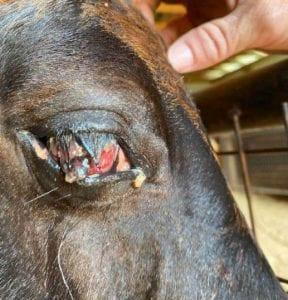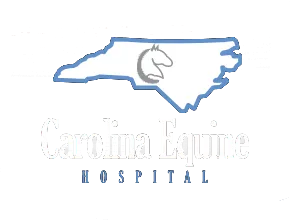Recognizing Common Equine Eye Conditions
- posted: Feb. 17, 2021
WARNING GRAPHIC IMAGES
Promoting good eye health for your horse is important. In our experience at the Carolina Equine Hospital, we observe many conditions that can cause issues for your horse long-term. We’d like to review just a few of the most common as well as some of the treatments that we would suggest.
Corneal Ulcers
Horses are particularly vulnerable to ocular trauma because their eyes are large and positioned on the sides of the head. Corneal ulcers are one of the most common eye conditions caused by trauma. The cornea is a transparent membrane in the front of the eye. Fluorescein stain dye sticks to the affected part of the eye, making it more visible. Corneal pathology (disease or damage) generally results in opacity, and various color changes can accompany this process. Other signs include squinting, eyelid swelling, and discharge.
Corneal ulcer treatment and prognosis depends on the defect’s depth. For uncomplicated (small and superficial) ulcers your doctor might prescribe a topical antibiotic to prevent infection and an oral anti-inflammatory. If the pupil is small (a pain response called miosis), he or she might apply a topical medication such as atropine to help with dilation. For complicated (infected, deep, large-diameter) ulcers, treating the horse in hospital is ideal because the eye might need medication every few hours and close monitoring. If corneal ulcers are treated early and aggressively, the prognosis for vision can be good.
Lacerations
Eyelid lacerations are also common results of trauma. The classic case is tearing that occurs when the horse “catches” his eyelid on a hook-shaped object (like the “J” on a bucket handle). After examining for coexistant eye damage, the veterinarian usually sedates the horse, administers local anesthesia, prepares the skin, and repairs the laceration. Aftercare usually involves systemic anti-inflammatories and antibiotics. If treated promptly, prognosis is good.
Conjunctivitis
Another common equine eye issue is conjunctivitis. The conjunctiva is the mucous membrane covering the inside of the eyelids and the white part of the eye. Clinical signs of conjunctivitis include eye discharge, redness, and swelling of these tissues. Causes include allergies and insect hypersensitivity, which can be treated with anti-inflammatories, antihistamines, and modifications to the environment.
Uveitis
Uveitis is an inflammatory condition of the middle layer of the eye. Complications associated with uveitis are the number one cause of blindness in horses worldwide. Uveitis is categorized as acute or chronic/recurrent. Vets will base their initial diagnosis on clinical signs of squinting, ocular discharge, corneal swelling, blood or pus in the anterior (front) chamber, and miosis, among others. Uveitis is immune-mediated and has multiple causes, both infectious (Leptospirosis, Streptococcus, equine influenza, and equine herpesvirus, to name a few) and noninfectious (trauma or tumors). Certain breeds, such as Appaloosas, are at higher risk for uveitis. Sometimes a cause isn’t apparent, and it must be treated symptomatically. Treatment consists of topical medication to dilate the pupil, topical anti-inflammatories (corticosteroids or non-steroidal anti-inflammatories), topical immunomodulatories, and systemic anti-inflammatories. Most horses with the acute form initially respond well to symptomatic treatment, but long-term prognosis might be guarded because of recurrence, and each episode causes further eye damage.
Medical therapies for eye disease can be prolonged and fraught with complications. In cases that cannot be treated for financial or medical reasons, enucleation (removing the eye) can be the best option for the horse. Study results show that horses can return successfully to a variety of disciplines following enucleation, and owners report satisfaction with the procedure and outcome.
CAROLINA EQUINE HOSPITAL
Is your horse experiencing a draining eye or the inability to open its eye? Has it suffered some recent trauma to the eye? Call our office to set up an appointment. If the injury happens after regular business hours we can treat your horse on emergency. We service equines in the Piedmont triad area.
Location
Find us on the map
Browns Summit Location
5373 NC Hwy 150
Browns Summit, NC 27214, United States


